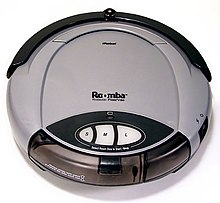Domestic robot: Difference between revisions
m Reverted 1 edit by 124.169.186.165 identified as vandalism to last revision by ShelfSkewed. |
m Check Wikipedia cleanup (Fixing links equal to linktext) + gen. fixes |
||
| Line 26: | Line 26: | ||
** [[LG V-R4000|V-R4000]] (by [[LG]]) |
** [[LG V-R4000|V-R4000]] (by [[LG]]) |
||
** [[Samsung Hauzen VC-RE70V|Hauzen VC-RE70V]] (by [[Samsung]]) |
** [[Samsung Hauzen VC-RE70V|Hauzen VC-RE70V]] (by [[Samsung]]) |
||
** [[ |
** [[V-bot RV10]] (by [[V-bot]]) |
||
** [[ |
** [[DC 06]] (by [[Dyson (company)|Dyson]]) |
||
* Ironing clothes: |
* Ironing clothes: |
||
** [[Dressman]] (by [[Siemens AG]]). |
** [[Dressman]] (by [[Siemens AG]]). |
||
| Line 70: | Line 70: | ||
**[[Toyota Partner Robot]]s, some of them [[wikt:mountable|mountable]]. |
**[[Toyota Partner Robot]]s, some of them [[wikt:mountable|mountable]]. |
||
== Domestic robots in popular culture == |
== Domestic robots in popular culture == |
||
Many cartoons feature robot maids, notably Rosie the Robot from [[The Jetsons]]. Maid Robots are especially prominent in anime (in Japanese, they are called Meido Robo or Meido Roboto), with their [[Artificial Intelligence|AI]] ranging from rudimentary to fully sentient and emotional, but appearance wise, they usually appear realistically human (sometimes to the point that they are capable of having [[sexual intercourse]] with humans), though some have features that give away their robotic identities (such as antennae). Multi aka HMX-12 and Serio aka HMX-13 from [[To Heart]] are prime examples. |
Many cartoons feature robot maids, notably Rosie the Robot from [[The Jetsons]]. Maid Robots are especially prominent in anime (in Japanese, they are called Meido Robo or Meido Roboto), with their [[Artificial Intelligence|AI]] ranging from rudimentary to fully sentient and emotional, but appearance wise, they usually appear realistically human (sometimes to the point that they are capable of having [[sexual intercourse]] with humans), though some have features that give away their robotic identities (such as antennae). Multi aka HMX-12 and Serio aka HMX-13 from [[To Heart]] are prime examples. |
||
Revision as of 07:52, 31 May 2009

This article needs additional citations for verification. (May 2008) |
A domestic robot is a robot used for household chores. Thus far, there are only a few limited models; science fiction authors have suggested that they could become more common in the future. In 2006, Bill Gates wrote an article titled "A Robot in Every Home"[1][2] discussing the significant potential for robots (including domestic robots) being accepted by society. There are different types and classes[citation needed]:
- Low level: a basic home robot is any robot that can be used at home, including the entertainment robots, like Aibo.
- Care and chore robots: used for household chores.
- The highest level robot is the domobot: used for household chores, autonomous and connected to a WiFi home network or smart environment. Some of them can also include a USB port.
There were an estimated 3,540,000 service robots in use in 2006, compared with an estimated 950,000 industrial robots.[3]
Domestic robots in production
Working or chore robots
- Robotic mop:
- Robotic vacuum cleaners:
- Ironing clothes:
- Dressman (by Siemens AG).
- Driron (by Fagor).
- Pets:
- Litter-Robot for cats

Home couriers
Home transport robots are a main element in the domestic robotic system, because they join specialized processes, moving objects at home (i.e. clothes from the bathroom to the washing machine or glasses from the table to the dishwasher):
- STR (by Iberobotics). It includes Wi-Fi and USB connection to (domotics) network.
- In 2006 Sharp said it has developed a humanoid robot that clears dishes from the table and puts them into a dishwasher. The robot (measuring 95x50x45cm) opens the door of the dishwasher, takes hold of teacups, rice bowls and plates, places them in the unit and closes the door [4]
General helper robots
There are also general domestic helper robots, i.e. HRP-2.
Outdoors

- Robotic lawnmowers
- RoboMower (by Friendly Robotics)
- The Husqvarna Automower
- Ambrogio by Zucchetti
- Automated pool cleaners are robots for cleaning swimming pools.
Entertainment
- Toy robots include
- Sony's Aibo, a robot pet dog also used by many universities in the RoboCup autonomous soccer competition
- Robosapien, a small humanoid remote controlled robot
- Furby, an electronic toy that was the must-have toy of 1998.
Social robots
- Robots whose main object is social interaction (partner robots) include:
- Wakamaru, a humanoid robot designed to provide company for the elderly and less mobile people, made by Mitsubishi Heavy Industries, on sale from 2005
- Paro, a robot baby seal intended to provide comfort to nursing home patients
- PaPeRo, a robot designed by NEC to study robot-human interaction.
- Sony's QRIO.
- NUVO
- PINO
- EMIEW
- Toyota Partner Robots, some of them mountable.
Domestic robots in popular culture
Many cartoons feature robot maids, notably Rosie the Robot from The Jetsons. Maid Robots are especially prominent in anime (in Japanese, they are called Meido Robo or Meido Roboto), with their AI ranging from rudimentary to fully sentient and emotional, but appearance wise, they usually appear realistically human (sometimes to the point that they are capable of having sexual intercourse with humans), though some have features that give away their robotic identities (such as antennae). Multi aka HMX-12 and Serio aka HMX-13 from To Heart are prime examples.
See also
References
- ^ www.sciam.com/article.cfm?id=a-robot-in-every-home
- ^ Scientific American: Search
- ^ http://blogs.spectrum.ieee.org/automaton/2008/03/21/10_stats_you_should_know_about_robots.html
- ^ Robot moves dishes from table to dishwasher - we make money not art
